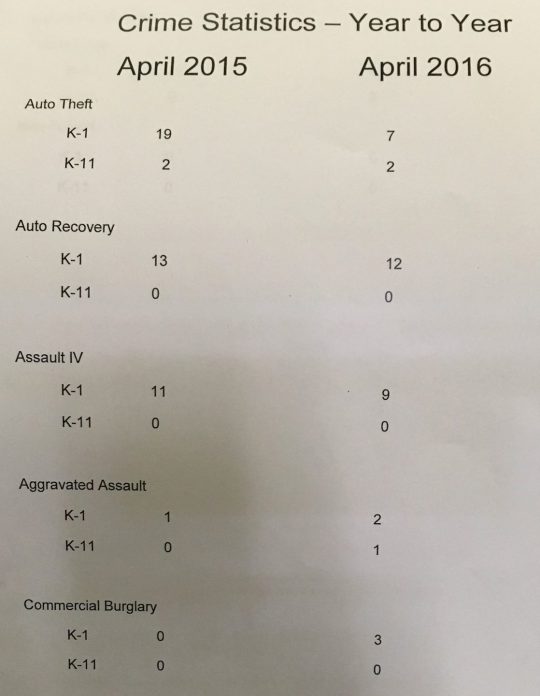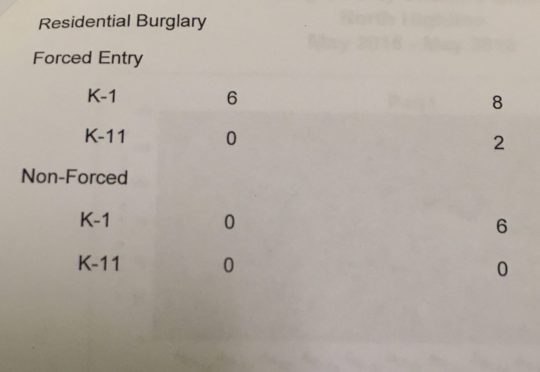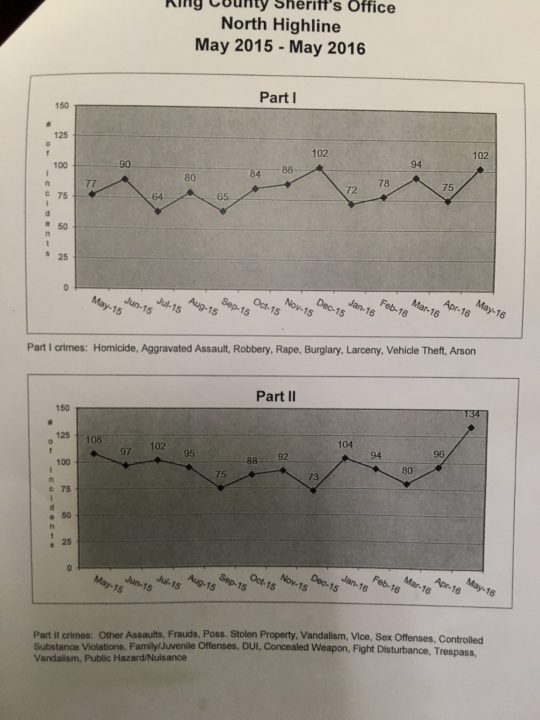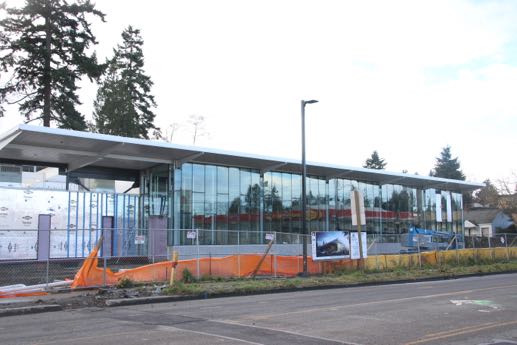By Tracy Record
White Center Now editor
“This is a conversation about marijuana and what it means about the health and future of our community,” is the statement with which North Highline Unincorporated Area Council president Barbara Dobkin began NHUAC’s January meeting.
The heart of that conversation last Thursday night was, how many marijuana stores in an area are too many – and is there any way to limit how many wind up in North Highline? Three licensed recreational stores already are open – two in Top Hat and one in White Center – with more seeking licenses; late in the meeting, it was pointed out, though, that last year’s crackdown on dispensaries already had dramatically reduced the overall number of places where marijuana could be obtained.
![]()
The meeting happened in a forum format, with the four panelists at the front of the room, rather than as a NHUAC meeting. They included North Highline’s two State House representatives, days before their return to Olympia for the new legislative session – Rep. Eileen Cody and Rep. Joe Fitzgibbon. Also, King County Sheriff’s Office’s area precinct commander, Major Jerrell Wills, was a late addition to the panel. First to speak was Laura Hitchcock from the King County Executive’s Office and Department of Public Health. An “interdisciplinary look at marijuana policy” is part of what she works on, she explained, working with a variety of agencies and departments.
She said they work on “balanced goals, given that our electorate did support legalization,” including “eliminating the black market” and “public safety” as well as “keep(ing) marijuana away from kids (because) it’s bad for the developing brain.” Also: “Closing the medical-marijuana loophole.” She discussed research while acknowledging there isn’t a lot of research on the effects of siting marijuana businesses since legalization is relatively recent. The county received a grant to look at local ordinances – “what kind of things were local governments and local communities wanting to regulate … mostly regarding the siting of marijuana businesses.” Regarding siting, the research found that “mixed-use zones” and “commercial zones” were the most likely to allow stores; the size of the store was the most common aspect to be regulated. Only one jurisdiction required a marijuana-business license.
The research is online and will be updated, Hitchcock said. “Partly because of this research, we were included in a new study that just started January 1st, a National Institutes of Health study to look at the impact of those ordinances – implementation of the policies, how they relate to retailer density, and … product, price, potency (in the retail market).” Plus: “We’re going to look at whether ay types of policies mitigate potential negative effects” such as youth use and impaired driving, among other outcomes. It’s a three-year study.
She added that King County and Seattle Children’s Hospital just found out they got a grant for $500,000 for 18 months for a countywide youth marijuana-prevention-education program. They’ll work with organizations that work with the groups that are at highest risks. Its specific goals: “We’ll do an assessment and planning in the first few months and as we implement the project we’ll look at prevention of marijuana use by ages 12-20 … supporting the development of reducing initiation strategies … environmental and system change strategies,” such as zoning. The program also will be trying to increase participation by stakeholders such as schools and service providers. There’ll be a youth advisory board for the entire county. “As King County has been working on this issue, we’ve heard from the community, especially in this area, about concerns of (siting) and youth impacts.” So they’re looking at changes the state made in 2015, and also at experiences Seattle is having, and the goal is to have some recommendations for the King County Council by the end of the first quarter of this year.
King County Sheriff’s Office Maj. Jerrell Wills opened by saying Sheriff John Urquhart opposes the granting of any further marijuana business licenses in this area.
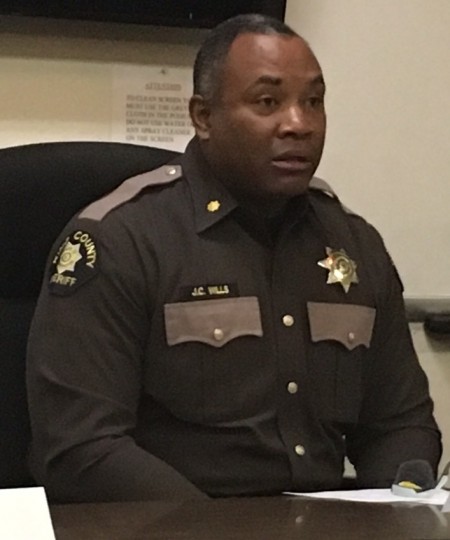
The input the county has with the state is similar to that of liquor licenses, he said. The sheriff believes “you have your fair share,” Maj. Wills said.
Next to speak, State Rep. Joe Fitzgibbon.
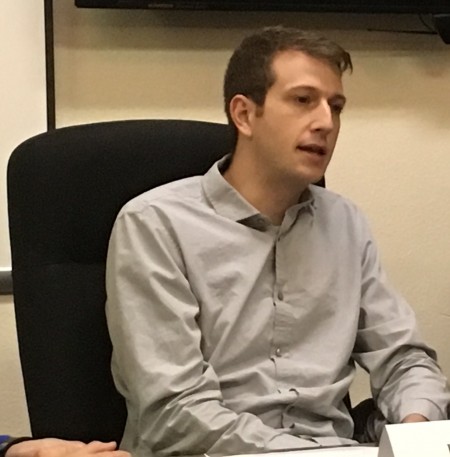
He worked on legislation this past year regarding financial effects, including the tax levied at three steps of the marijuana production/selling process. They were looking at levying the tax “at one step of the process,” especially because Oregon was just coming online and they didn’t want Washington taxes to be “vastly higher” than Oregon. There was a sales drop in Washington when Oregon started selling, he said, though they don’t know how much of that was because Oregon pot smokers had been coming into Washington until it was legal in their state.
“One of the things that was interesting about this issue – we weren’t just the first state to legalize marijuana, but the first state to have a legal, regulated market in marijuana,” beyond decriminalization, Fitzgibbon said. “We had to do a lot of guesswork about what was going to be the right way to set up a system.” Colorado was going through it at the same time and one advantage they had, he said, was a regulated medical-marijuana system, unlike our state’s “gray area.”
So taxes were consolidated and lowered somewhat, and now shared with local governments, as a result of last year’s changes, he said, figuring out “what’s the right split … do you give some of the money to a jurisdiction like Federal Way that has banned marijuana from being sold in their borders … how much do you give local governments and what can they use it for. … Even now we’re still flying blind on how much money is going to come in from 502.” The money is “lower than a lot of the estimates were.” And he says the state is somewhat hampered by the fact the feds won’t allow research on its impacts. “So we’re going a lot off of anecdotes, people’s gut instincts on how much pot people are smoking, how much is in the black market, how much is in the legal market …” So “we ended up providing not as much money as local governments wanted,” which leads to communities like this one wondering if the county will “rope off the money coming from stores in WC and keep that money for use in WC? That’s a legitimate question … to figure out.” And that, he said, is also a reasonable question for Seattle to figure out regarding an area with a concentration of marijuana businesses.
Rep. Eileen Cody said that “from the medical side it’s been interesting.”
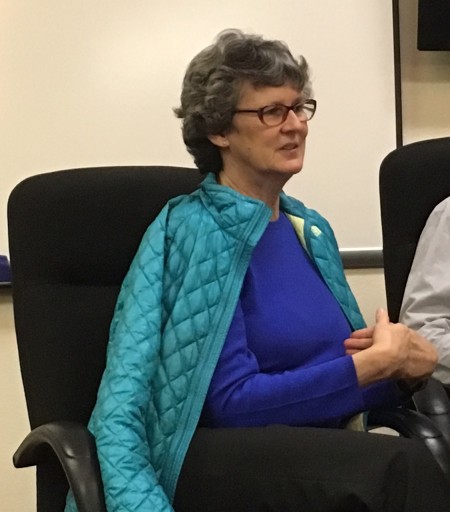
She said that so many things have changed over the years of medical marijuana ‘because we believed it had benefit for people.’ Then, “things kind of got out of hand … and we did try to pass a bill that would have been similar to what we’re doing now, medical marijuana would have been grown, and tested …” She recapped the travails of trying to regulate medical marijuana, and then-Gov. Chris Gregoire‘s veto of parts of the bill. “Probably would have been better if she’d vetoed the whole bill,” Rep. Cody said, because the parts she didn’t led to growth in the number of dispensaries “which got totally out of hand.”
“It’s an interesting issue when you get into a marijuana fight – it’s not partisan,” Cody said, with some supporters and opponents in both parties, “you can’t tell where someone’s going to be at by whether there’s a D or R by their name. And already … there’s a lot of money involved,” with many more marijuana lobbyists. “Thats only going to grow, kind of like big tobacco. … In this past year we did get legislation passed to be sure that the dispensaries … the recreational marijuana is tested much more than the medical marijuana was,” and they’ve been trying to work on that.
Overall, she said, “there were some hard feelings on the marijuana legislation,” even people telling her she was a discredit to her profession (nursing). She says the medical-marijuana community is still concerned that there won’t be enough and that recreational stores won’t carry what they need – lower THC, higher cannabinoid, opposite of what recreational users want. They can’t force stores to carry it, she said, but they will need a special license if they want to. “We’re trying to get it so there’ll be more training, some kind of certification for people who are more knowledgeable about the medical side of things … but as Joe mentioned, there’s no research (that’s been allowed).”
Overall, “things have calmed down a bit … and the medical side has accepted that this is how things are going to move forward.” On the medical side, it’s been a “very interesting trip,” Rep. Cody said, even as they tried to have it treated as a drug – with the request for the feds to treat it as “Schedule 2,” allowing doctors to prescribe it. “It’s a very hard thing for medical professionals, but if it helps, they want people to be able to get it.” She lauded King County for closing down some of the dispensaries – 15 out of 18, according to the latest stats – and she hopes that Seattle will get some closed down too.
Hitchcock added, regarding recently passed legislation, that local governments got the ability to reduce buffer zones to as little as 250 feet. “I think there will be a lot of activity around that.”
Fitzgibbon said it’ll take years to know what the effects are in criminal justice and other areas. “We know local government has faced expense in just implementing the law … coming up with policies … (especially) starting from scratch with rules on how to site a farm, a processing plant, a retail store.” He said that Mexican cartels have “seen their revenue crash” as legalization and decriminalization spread across the country, but so far there’s no evidence of changes in crime as a result.
Audience Q & A included a question from a resident in unincorporated Skyway concerned about “the implementation of actual retail stores … the small areas of Skyway and White Center, a population of only about 35,000, have all the retail stores licensed so far – 7, and two more in the process -” for unincorporated King County, which he said would be akin to 200 for the city of Seattle. He said he’s concerned that trend will continue.
Karen Freeman from the county executive’s office, sitting in the audience, said, “Part of the issue is that the county used to have 12 very large unincorporated areas, and seven of them have been annexed in recent years. So the urban unincorporated area of KC has shrunk significantly – five now, all south of Seattle – and so those are the (only) areas where people in KC can apply to site. … So you end up with this concentration.” The Skyway resident said the state policy “doesn’t look at that at all.” King County’s Hitchcock said the state has no authority and responsibility to determine if there’s an overconcentration. “Is it equitable, just, fair?” asked the Skyway resident. “If not, should it be changed immediately?” Hitchcock said the changing of buffer rules might lead to more areas where they are allowable.
Another attendee said that she wonders if the county and state are left open to a lawsuit for disproportionate effects on communities of color among others.
Fitzgibbon noted that the concentration of dispensaries has dropped, but with 502, yes, you probably will see more stores in White Center on a per-capita basis than in Snoqualmie, for example, “because people are more spread out there.” He said it’s too soon to say if the concentration of 502 stores will lead to undesirable effects – including public safety – because they’re regulated, unlike the dispensaries. “I know it’s going to be better than it was during the bad days of the dispensaries.”
Hitchcock said they’re interested in hearing from residents on “what should be the dispersion model” if communities are disproportionately affected, starting with what those effects area. “That’s a conversation that the county interbranch team is starting to have,” including a look at zoning effects.
“What about the licenses in the process at this point?” – would they be grandfathered? “Yes,” Hitchcock said. Another county rep in the room said that they’re working to come up with land-use reps this quarter.
NHUAC board member Elizabeth Gordon, who is affiliated with what’s currently White Center’s only 502 store, talked about the realities of licensing, including having a location where the landlord will allow it. She noted that WC has “a lot of vacant stores,” and business owners who hold out “until the property taxes are due,” for example. She mentioned the SODO openings because owners who get licenses “have to be open somewhere.” And she suggested the commercial property owners in the unincorporated areas are “not at the table,” and are being affected by vacancies because there’s no sustainble-economic planning.
The attendee concerned about the social/economic-justice effects noted that where negative effects are concentrated, the positive effects are diffused.
Another attendee asked about what KCSO Maj. Wills is seeing regarding crime – he pointed out the crimes that have happened at the NiMBiN store in Top Hat, for example (without naming it). “Obviously the cash is a concern for WC and Skyway,” Wills began. He also said some of these businesses don’t necessarily embrace the KCSO presence. He also recalled seeing the “lines” of customers at dispensaries that are now closed – “what they were doing on their way in and on their way out wasn’t positive, I (was) hearing from our deputies.” Overall, he said, they still have big concerns, and see this as “a big challenge for our community and the Sheriff’s Office.”
NHUAC president Dobkin pointed out that a processing facility opening in the Top Hat area is in the same building as a “collective,” and it’s close to residential, “mostly low-income apartments.”
A rep from the county permitting department said that the owner of the processing facility has come to the county but hasn’t been in active contact since spring. “They have submitted the application but have not followed through, but I’m not sure that it’s going to open any time soon.” Dobkin said she was concerned because she’s seen “active work” on the building. Use up to 2,000 square feet doesn’t require a permit, she said, or for retail, up to 5,000 square feet; with a permit, it could go up to 30,000 square feet, and that would require community input.
Dobkin noted that people are notified within a certain radius and that nearby residents in some areas might not necessarily respond. She didn’t hear about it until it was too late. The permitting rep said applicants are required to put up a 4 x 8 sign, including a phone number – “you can always call us to ask what the sign is about.”
NHUAC board member Liz Giba observed that “there are a lot more questions than there are answers. We don’t know what this is all going to mean, eventually. I really resent the (sentiment) from King County that we can be used as a guinea pig to gather data from. I think this neighborhood needs to be supported, not used. So I’m wondering where in the conversation is the county regarding at least putting a moratorium in place for Skyway and King County, given that we’ve got more than our fair share of stores. … Are you looking at or recommending a moratorium until we can see how all this is going to play out?”
The permitting rep said, “We want to talk with the community, we want to hear from the community about what your concerns are … we want to hear that from you guys.” She mentioned businesses using multiple addresses for license applications because they then will figure out where they will locate if and when they get a license – so the number of applicants is actually fewer than it appears.
“But we’ve seen the results,” said the Skyway resident. “All the stores are in White Center and Skyway.” (So far there actually is one White Center store, two in Top Hat.) He said he’s not seeing King County’s comments; the county permitting rep says, “We say yes from a permitting point of view” – picked up another rep, “if the application is in an area zoned for this use.” But, the Skyway rep said, you’re asked if you approve of the applicant.
“So do we need a new law?” Giba asked.
“You need new zoning in King County,” Rep. Cody said.
A county rep said, “They’re not required to take our feedback into consideration when making a decision.” She used as an example liquor-license applications that were approved even when the county said that it wasn’t appropriate zoning.
There are now 22 stores to be allotted in unincorporated King County and “the smallest cities,” said the Skyway rep.
Rep. Cody said consumers/patients are voicing concerns about their access, and it’s important to take into account the fact dispensaries have been closed.
“As a nurse, how many points of access would you think are necessary for 18,000 people?” asked the Skyway resident.
“We have no idea,” said Rep. Cody, noting again that there used to be a multitude of dispensaries. Seattle, for example, had more than 200 of them, and the LCB was looking at how many could be sited. “Now 42,” added the Skyway resident.
After some contentious back and forth, a county rep pointed out that “a lot of people voted for (I-502)” so the county’s job is to figure out how to get feedback and how to balance differing opinions and interests. “We want to hear more from you about what you want, what you don’t want, what you like.”
“But this conversation isn’t happening elsewhere in unincorporated King County,” pointed out the Skyway resident.
One White Center resident who said he supports 502 says he just wants it to be a “safe place” where “young families can come down … I want them to feel safe in bringing the kids downtown … I just don’t know how it’s going to be regulated. … Where does this leave us in the meantime? In the next year, are we going to have more stores in downtown White Center, and how is it going to be regulated?”
Hitchcock said the county could change zoning and limits but the question would be regarding the licenses that are in process. Cody said that she and Fitzgibbon can feed back to the Liquor and Cannabis Board that there are concerns about disproportionality.
The executive is expected to send the county council a proposal soon, said Alan Painter, yet another King County rep who was sitting in the audience. So, he exhorted, work with the county now. “The concerns of the White Center community have been heard, the concerns of the Skyway cmmunity have been heard there are some differences of opnion over that, it’s going to be sorted out over the next three months.”
Dobkin pointed out that they’ve been voicing their concerns over the past year and they don’t feel they’ve been heard.
Painter said he disagreed – “there were 18 dispensaries and now there are three” (following the summertime crackdown announcement).
“But now we’re talking about the stores,” she said, and noted that regarding dispensaries “it took until there were eight in our little community before there was a moratorium,” though they were illegal to start with. “We have been speaking up for a long time about this.”
NHUAC board member Giba asked Painter if the sheriff gets copies of the requests for information before the state grants licenses. “Is he listened to any more than you are?”
A county rep replied yes, it’s similar to liquor-license input.
Hitchcock said that state law says they only have to take into consideration criminal behavior, so it’s important that they hear about criminal behavior if it’s going on.
Maj. Wills says he does get liquor license renewal forms looking for info.
He was challenged by an attendee saying that state liquor control board reps at community-safety meetings in past years said they never got input from KCSO.
Subsequent discussion brought up whether anyone was trying to limit the number of stores. Hitchcock asked about the primary concern – diversity of businesses, youth use, crime, or … Dobkin said White Center is challenged on a variety of fronts and that’s the main concern, “is this helping the community in any way …. and yes, we do need better diversity of businesses .. we had a yoga studio in downtown White Center that couldn’t stay open longer than a year, we have two halal stores that shut down” even though the area has a large Muslim population, and she said its owners reported their customers didn’t feel safe coming downtown.
It was noted that the county is apparently getting almost a million dollars from marijuana tax this year. What if that money all stayed in WC? How would the community feel? asked an attendee.
Freeman from the county executive’s office said she thinks that number is inaccurate – too high. Challenged on that point, she promised to do research on the expected amount of money and what will be done with it.
Hitchcock at that point said that much of the studies she’s mentioned will focus in south King County. It was then suggested that the focus should be on changing the county’s zoning policies, which are what’s being enforced here. Dobkin said it was never clarified previously “who was in charge.” Hitchcock clarified that the county is accountable for zoning, not licensing.
Dobkin said they’ve been in close contact with local County Councilmember Joe McDermott, including a walking tour and many phone conversations, regarding concerns.
A lawsuit was brought up regarding Bellevue’s dispersion rule – “it’s being challenged to the state court of appeals,” said Hitchcock. It could be relevant here because of the precedent, she added in response to a question.
One attendee clarified that she is not saying that a vibrant business district couldn’t include marijuana businesses.
Another asked what the KCSO is seeing regarding marijuana uses among youth. Maj. Wills said, anecdotally, “we are seeing a steady rise with youth utilizing marijuana -how they’re getting it, I’m not going to suggest. … Without making a societal statement here, perhaps the acceptance of marijuana and other drugs is making it more appealing …”
Rep. Cody said the reports have been that more kids are “vaping” marijuana, though it’s not necessarily that they’ve gotten it from one of the 502 stores. “But the real problem we have is heroin – we have a heroin epidemic going on. I had a kid in my office last year, he is clean now, he was raised in Bellevue, and how he had gotten addicted was from opioids from a knee injury in high school, that a (doctor) let him have,” and then when his prescriptions expired, he started smoking heroin, then shooting up, then flunked out of school and finally got treatment.
In the end, no conclusions, but a spirited discussion.
NHUAC meets most months on the first Thursday, 7 pm, at the North Highline Fire District HQ, 1243 SW 112th.

